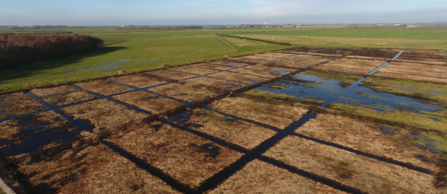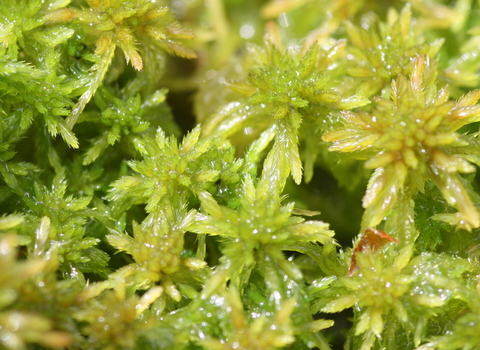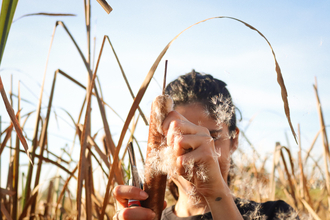Plugs of sphagnum moss at the Winmarleigh carbon farm
Winmarleigh carbon farm
The Winmarleigh carbon farm is a pioneering project that is working to restore the carbon storage capacity of lowland agricultural peatlands
Many of our lowland peatlands have been drained and converted to farmland, this causes the release of large amounts of greenhouse gases into the atmosphere contributing to the climate emergency.
The carbon farm is piloting a different way of managing lowland peat soils, which protects their vital soil carbon whilst keeping the land financially viable for farmers and landowners.
What is carbon farming?
Carbon farming is a way of managing land to reduce greenhouse gas emissions and sequester and store further carbon. The ‘crop’ from the land is the carbon (or carbon dioxide equivalents, a way of counting all the different types of greenhouse gases, often shortened to just the term carbon) that is saved. This ‘crop’ can then be ‘sold’, the funding coming from government subsidies and/or payments from organisations looking to offset unavoidable carbon emissions.

The Winmarleigh carbon farm
When water is drained from a peatland, as is required to convert it from a bog to an agricultural field, this causes the peat to oxidise. As peat is an incredibly carbon-rich soil, when this carbon is exposed to oxygen carbon dioxide is formed which is then released into the atmosphere as a potent and dangerous greenhouse gas that is contributing to the climate emergency.
However, if you re-wet the peat and replace the top layer of peat-forming vegetation, such as with sphagnum moss, these emissions can be stopped and as new peat is formed further carbon can be sequestered (absorbed) from the atmosphere.
Can you farm carbon? (https://youtu.be/CkiqMaLxdjg)
The Winmarleigh carbon farm video by MediaLife
How do you create a carbon farm?
The carbon farm site was once part of Winmarleigh Moss, a lowland raised peat bog that formed after the last ice age. It was drained and converted to farmland in the 1970s, with additional drainage being added in the 1990s.
BLOG: What are peatlands and how did they form?
Creating the carbon farm required a number of steps:
Irrigation ditches cross the carbon farm maintaining water levels
- The top 10cm of nutrient-enriched topsoil was removed to reveal the peat underneath.
- Bunds were installed to start the process of re-wetting the peat. Bunds are waterproof barriers of compressed peat that stop water from leaving the site.
- The existing field drains were blocked. Along with the installation of the bunds, this started the vital process of re-wetting the peat. Lowland peatlands are entirely fed by rainwater so it was essential that any rainfall could be trapped on the site.
- Irrigation channels were dug to help ensure that the whole site remained wet and with a relatively constant water table (ideally no more than 10cm below the ground surface). The bunds and irrigation channels work to divide the carbon farm into eight 50m x 50m cells.
- A large water retention pool was dug to capture excess rainfall. A solar-powered pump system was installed to automatically pump water from the pool to the irrigation channels if the water level dropped too low.
- 150,000 plugs of sphagnum moss were planted to start the process of re-vegetating the peat.
One of the thousands of plugs of sphagnum moss that have been planted at the Winmarleigh carbon farm
Researchers from Manchester Metropolitan University taking greenhouse gas measurements at the Winmarleigh carbon farm
The results so far...
We have been working with researchers from Manchester Metropolitan University to take regular greenhouse gas measurements from both the carbon farm and an adjacent control plot of drained pasture.
In the first year (December 2020 – November 2021), while the sphagnum was establishing, and so mainly due to the re-wetting of the peat, we saw an 86 per cent reduction in greenhouse gas emissions from the carbon farm site.
-
The adjacent drained pasture was emitting 24.4 tonnes of CO2 equivalent per hectare per year
-
The carbon farm was emitting 3.4 tonnes of CO2 equivalent per hectare per year
Over the 2 hectare carbon farm site this is a saving of 42 tonnes of CO2-e, the same as driving an average car 104,253 miles – or four times around the world!
Why Winmarleigh?
Winmarleigh Moss SSSI (Site of Special Scientific Interest) is one of our region’s best-preserved examples of a lowland raised peat bog, an amazing habitat which we have lost 98 per cent of in our region. The carbon farm site sits right next to one edge of the SSSI, and the drainage from the site, and the deep drainage ditch that separated the two areas, was causing significant water loss and drying out the peat on Winmarleigh Moss itself.
Blocking the drainage ditch between the two areas, and raising the water table on the carbon farm site has helped to improve water levels on Winmarleigh Moss, helping to restore this precious fragment of peatland.
There are benefits to farmers and landowners too. The carbon farm site was notoriously difficult to farm, being boggy and regularly flooding in winter. As peatlands are naturally low in nutrients, the site also required significant amounts of artificial fertilisers to make it viable pasture.
However, by managing the land as a carbon farm, and once it has become more established, the area should require very little maintenance and could provide a similar or higher financial yield than traditional farming. We have been working with experts at Manchester Metropolitan University to create an economic business case for the carbon farming model that will support this.
Explore the area
Have a go with our interactive map and explore the carbon farm and Winmarleigh Moss!
Care-Peat project

The carbon farm project is part of Care-Peat, an Interreg NWE funded project looking at restoring the carbon storage capacity of peatlands at seven pilot sites across five countries in north west Europe.
After the Care-Peat project completes in 2023, we will continue to operate and monitor the carbon farm, initially helped by the Precious Peatlands funding stream.
Other climate and nature friendly options for managing lowland peat
Carbon farming is just one option that we are exploring to find climate and nature positive ways to manage lowland peat in a financially viable way. Other options could include:
Celery plug plant at the Rindle wetter farming trial - credit Lancashire Wildlife Trust
Wetter farming
Wetter farming, also known as paludiculture, explores ways to grow crops on re-wetted peat soils. Our Rindle wetter farming pilot in Greater Manchester is trialling growing celery and bulrushes, with further plans for radishes and sunflowers, on what was once a drained area of peatland being used to grow potatoes.

Sphagnum moss by Vicky Nall
Sphagnum farming
Sphagnum farming grows sphagnum moss for use to replace peat in the horticultural industry. In this case the sphagnum moss is harvested, dried and combined with other materials to form compost. Carbon farm project partners BeadaMoss® (who supplied the 150,000 sphagum moss plugs grown on the carbon farm) are undertaking numerous trails in this area.







